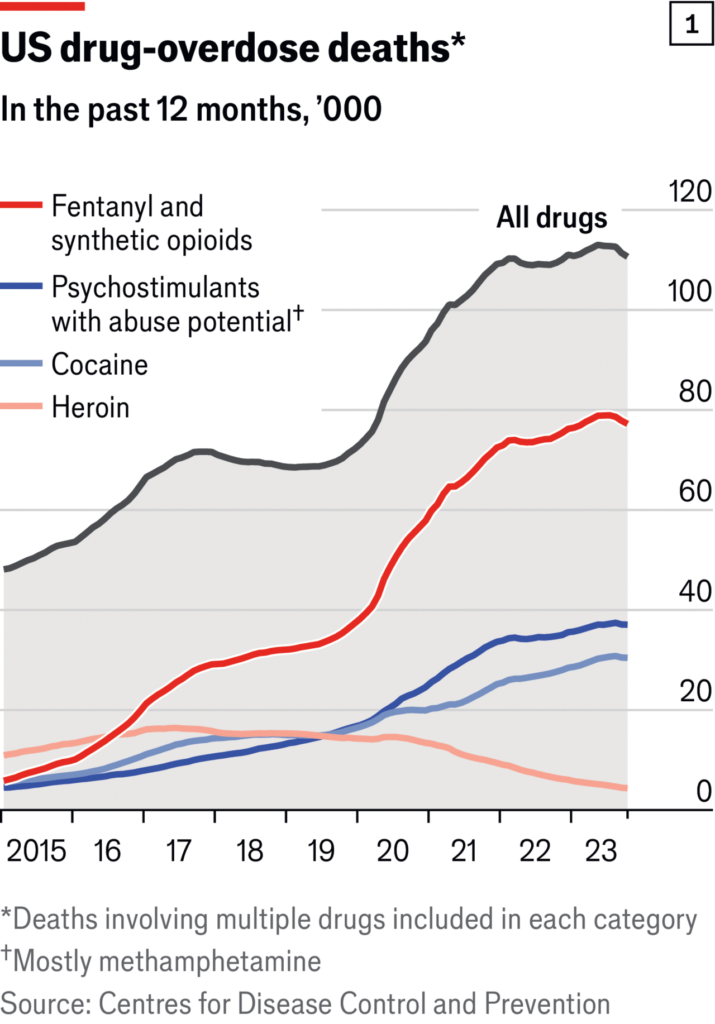
As reported by the WSJ, China is contemplating providing assistance to address the fentanyl trade in North America, which could serve as a catalyst for resuming trade discussions with the U.S. The opioid epidemic results in tens of thousands of overdose fatalities annually in both the U.S. and Canada, with China being a key player in the North American fentanyl market.
Anonymous sources cited by The Wall Street Journal suggest that China may propose collaboration on the fentanyl crisis to reduce tensions and foster dialogue with the Trump administration. Given China’s substantial involvement in the issue, it has the means to help tackle the North American fentanyl crisis. Reports indicate that Chinese chemical companies export fentanyl precursors and engage in consultations with American individuals interested in synthesizing the drug via online platforms.
China might be seeking to engage in discussions, particularly since the fentanyl issue was highlighted by Donald Trump when he defended the imposition of hefty tariffs on China, the only country not granted a 90-day tariff respite. A dialogue between the U.S. and China appears plausible; recently, Trump remarked that it is “a natural thing to ask” regarding China’s potential assistance in mediating conflicts between Russia and Ukraine.
Fentanyl Crisis Statistics
The terms “fentanyl crisis” and “fentanyl epidemic” are indeed warranted, given the tragic situation.
Fentanyl, a synthetic opioid used medicinally as an anesthetic, is far more potent than heroin or morphine. Its recreational use surged in North America during the 2010s, leading to hundreds of overdose fatalities daily. In 2022, fatal overdoses from synthetic opioids (mainly fentanyl) hit nearly 80,000 in the U.S. alone.
In Canada, where the population is five times smaller, the figures are less alarming, with approximately 6,000 fentanyl-related deaths recorded in 2023. However, when examining the statistics per 100,000 individuals, Canada’s figures are approaching those of the U.S.

Most overdose victims are men under 45, although there is a growing number of older adults among the casualties. The crisis affects individuals from all demographics, including young children.
To appreciate the scale of this tragedy, consider that at its peak, fentanyl was claiming one life every hour in Canada and one every seven minutes in the U.S.
Despite a decline in fentanyl-related deaths in both countries after 2022, the scale of the epidemic remains alarming. The Council on Foreign Relations notes that the 2022 death toll from fentanyl was ten times greater than the combined casualties suffered by the U.S. military in Iraq and Afghanistan. Comparisons to military conflicts are not unfounded, as the death toll from fentanyl rivals those resulting from severe military conflicts in the 2020s in areas such as Sudan, Gaza, Yemen, and Ukraine.
Remarkably, North America has experienced war-scale casualties without engaging in a conventional conflict—aside from the trade war. The two primary nations affected by the most severe tariffs, China and Mexico, play significant roles in the fentanyl trade in America. Canada, facing considerable tariffs, has also contributed to the issue, notably through Valerian Labs supplying fentanyl.
Fentanyl Trade: China, Mexico, and Cryptocurrency
In 2022, the Drug Enforcement Administration identified China as the leading source of fentanyl-related deaths among Americans. The drug typically reaches North America from China through mail or via Mexico. Two years later, a Congressional committee suggested that China is subsidizing the production of fentanyl precursors that are converted into illegal drugs in North America. The report states:
“The PRC (People’s Republic of China) classified all fentanyl analogues as controlled substances in 2019, indicating that it currently subsidizes the export of drugs that are illegal under both U.S. and PRC law. [Some of the substances] have no known legal use worldwide.”
Chinese officials deny any wrongdoing, claiming cooperation with U.S. enforcement efforts to combat trafficking.
Meanwhile, cryptocurrency serves a dual function. A Chainalysis report from February 2025 highlighted how digital assets facilitate and expose aspects of the fentanyl trade. On darknet markets, fentanyl and its precursors are often traded using Bitcoin or Monero.
Chainalysis noted that some participants do not anonymize their transactions, enabling analysts to trace trafficking networks. While cryptocurrencies allow for remote drug purchases and laundering, they also introduce transparency absent in cash transactions.
“While the cartel may have benefitted from speed, low transaction fees, and cross-border efficiency, their reliance on the blockchain has enabled investigators to trace these transactions more easily than would have been feasible with traditional cash-based money laundering. This also presents a greater potential for disruption, as issuers and centralized services often have the capability to freeze assets when necessary.”
This illustrates a less obvious way in which cryptocurrency supports drug trafficking while simultaneously disrupting illegal substance markets.
Conclusion
It is unclear whether China is genuinely inclined or able to dismantle its extensive fentanyl supply chain. Nonetheless, it represents a powerful bargaining chip as trade discussions with the Trump administration are on the horizon. In 2019, Assistant U.S. Attorney Matt Cronin candidly stated: “It is a fact that if the People’s Republic of China wanted to shut down the synthetic opioid industry, they could do so in a day.”






